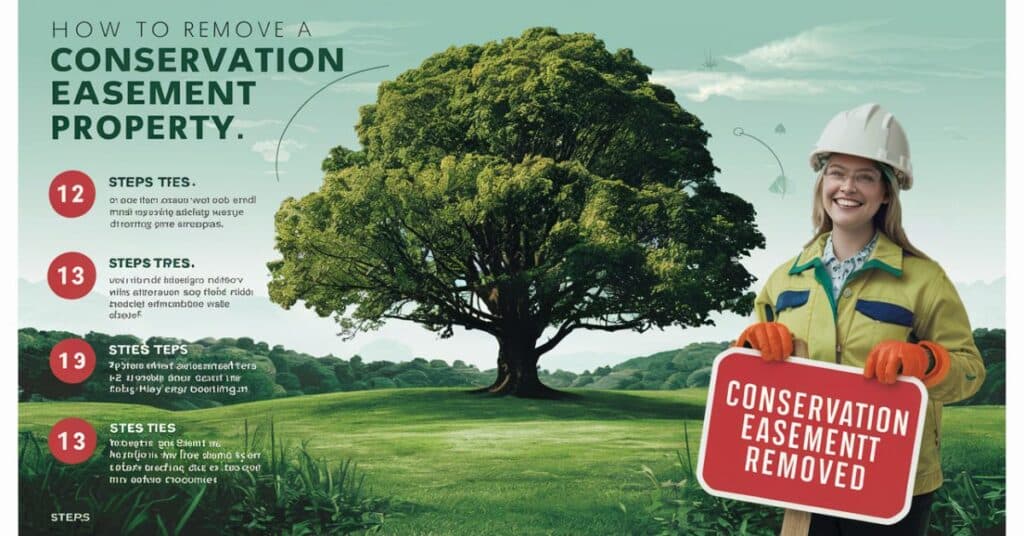Interested in removing a conservation easement from your property Discover the straightforward steps to legally release your land from conservation restrictions.
Understanding the legal steps is essential. Thoroughly review the agreement’s terms. Engage in potential negotiations with the grantor. Explore legal avenues with expert guidance.
Unlock the secrets to freeing your property. Dive into the intricacies of conservation easement removal. Navigate legal pathways with confidence. Ready to embark on the journey Learn How to Remove a Conservation Easement from Your Property.
Reveal the strategies for liberating your property. Delve into the intricacies of conservation easement removal. Navigate legal pathways with confidence
Consult legal experts for removal options.
Legal experts possess the knowledge and experience to navigate the intricacies of conservation easement removal. They can assess the terms of the agreement and determine the most viable removal options available to you.
By consulting with these professionals, you gain clarity on the potential legal implications and consequences of removing the easement.
Furthermore, legal experts can guide you through the negotiation process with the grantor or holder of the conservation easement. They can help you present your case effectively and explore possible alternatives to outright removal.
Their negotiation skills and legal acumen can significantly impact the outcome of discussions and potentially lead to a favorable resolution.
In addition, legal experts stay abreast of any changes in relevant laws or regulations that may affect the removal process. They can provide up-to-date advice and ensure compliance with all legal requirements throughout the removal proceedings.
By entrusting this task to knowledgeable professionals, you can proceed with confidence knowing that your interests are well-protected.
Ultimately, consulting legal experts for removal options empowers you to make informed decisions regarding your property’s conservation easement.
Their expertise, guidance, and advocacy play a crucial role in navigating the complex legal landscape surrounding easement removal. With their assistance, you can pursue the best course of action to achieve your goals while safeguarding your rights and interests.
Review terms of the easement agreement.
Examining the easement agreement uncovers specific conditions and restrictions. This includes limitations on land use and development rights.
Legal language within the document clarifies the scope of the easement. Seeking clarification on any ambiguous terms is advisable.
Close scrutiny of the agreement reveals any provisions for modification or termination. Some agreements may include expiration dates or conditions for release.

These clauses offer potential pathways to remove the easement. Legal guidance can help interpret and navigate these terms effectively.
Furthermore, assessing the feasibility of modifying or removing the easement hinges on a thorough understanding of its terms.
Identifying any loopholes or ambiguities may provide leverage in negotiations. Thus, meticulous review of the easement agreement is essential for devising a strategy to proceed.
Read this blog:https://businessnexa.com/find-a-section-8-houses-for-rent-with-no-deposit-revealed-2024/
Seek negotiation with grantor or holder.
Communicate your intentions clearly and respectfully to the grantor or holder of the conservation easement. Express your reasons for seeking modification or removal and be prepared to provide supporting information.
Emphasize the potential benefits of amending the easement while addressing any concerns raised by the grantor. Maintain an open-minded approach during negotiations and be willing to compromise if necessary.
Understand that reaching a resolution may require patience and flexibility from both parties involved. By fostering constructive dialogue and demonstrating a willingness to find common ground, you can increase the likelihood of achieving a favorable outcome in your efforts to remove the conservation easement from your property.
Assess feasibility of legal modifications.
Determining the feasibility of legal modifications requires a comprehensive understanding of the specific circumstances surrounding the conservation easement.
This involves analyzing factors such as the original intent of the easement, any provisions for modification or termination, and the impact of proposed changes on conservation goals.

Consulting with professionals experienced in conservation law can offer valuable guidance on navigating these complexities.
Once the relevant factors have been assessed, it’s essential to weigh the potential benefits and risks associated with pursuing legal modifications. This includes considering the financial costs, time investment, and potential legal challenges that may arise during the process. Conducting a thorough cost-benefit analysis can help property owners make informed decisions about whether pursuing modifications is a viable option.
In some cases, alternatives to outright modification may be available, such as renegotiating the terms of the easement with the grantor or exploring conservation tax incentives.
These options can provide flexibility while still achieving the desired outcomes for the property. However, it’s important to carefully evaluate these alternatives to ensure they align with both the property owner’s objectives and the original intent of the easement.
Ultimately, the decision to pursue legal modifications to a conservation easement should be made in consultation with legal and conservation experts.
By thoroughly assessing the feasibility of such modifications and weighing the potential benefits and risks, property owners can make informed choices that best align with their goals while respecting the principles of conservation.
Consider alternative conservation solutions.
When thinking about conservation, it’s important to explore various options beyond the traditional approaches. One alternative is to implement sustainable land management practices that promote biodiversity and ecosystem health.
This could involve practices like rotational grazing, reforestation, or creating wildlife corridors. Another alternative is to engage in community-based conservation efforts, where local communities play a central role in managing natural resources.
This approach fosters a sense of ownership and stewardship among community members, leading to more effective conservation outcomes.
Additionally, investing in technology-driven conservation solutions can offer innovative ways to protect natural habitats and species. This includes using drones for monitoring wildlife populations, implementing satellite imagery for habitat mapping, or employing smart sensors for tracking environmental changes.
Finally, collaborating with private landowners to establish conservation easements or land trusts can be a valuable alternative. By voluntarily restricting certain land uses in perpetuity, landowners can protect ecologically sensitive areas while still retaining ownership of their property.
These alternative conservation solutions provide flexibility and creativity in addressing environmental challenges while promoting sustainable development.
Explore judicial avenues if necessary.
When discussions reach dead ends, legal recourse may be essential. Turning to the judicial system can provide clarity and resolution. If negotiations falter, seeking court intervention becomes crucial.
Before proceeding, grasp the intricacies of legal proceedings.
In instances of impasse, legal avenues offer potential solutions. Through court intervention, disputes can find resolution. When dialogue proves fruitless, judicial routes offer a path forward.
Understanding legal ramifications is imperative before initiating any legal action. When negotiations stall, legal options warrant consideration. Judicial pathways offer mechanisms for resolution.
If discussions prove unproductive, court intervention becomes imperative. Prioritize comprehension of legal complexities to navigate proceedings effectively.
In cases of deadlock, legal avenues offer a lifeline. The judicial system provides channels for resolution. When negotiation efforts wane, turning to the courts becomes necessary.
Income Tax Advantages from Donating a Conservation Easement
Donating a conservation easement can offer significant income tax benefits. By relinquishing certain property rights to a qualified organization, landowners may be eligible for valuable tax deductions.
These deductions can include reductions in income tax liabilities, potentially resulting in substantial savings. The Internal Revenue Service (IRS) allows qualified conservation easement donations to be deducted from federal income taxes.
The amount of the deduction is typically based on the appraised value of the easement’s conservation value.
Landowners may also benefit from reduced property taxes and estate taxes, further enhancing the financial advantages of donating a conservation easement.
Exploring and Celebrating the World of Agriculture
The agriculture reveals diverse practices and innovations. From traditional farming methods to modern technology, agriculture offers a vast landscape of possibilities.
Farmers cultivate crops, raise livestock, and manage land to sustain communities worldwide. Celebrating agriculture honors the hard work and dedication of farmers.
Their commitment feeds nations and sustains economies. Agricultural festivals, fairs, and events showcase the richness of rural life and the importance of farming in our daily lives.
Joining in agricultural exploration and celebration fosters appreciation and understanding. From farm tours to agricultural museums, opportunities abound to learn and engage. Embracing the world of agriculture ensures its vitality for generations to come.
Exploring Texas: Ranches, Farms, and the Talk of the Town with our new Team Members
Exploring Texas unveils vast ranches and thriving farms across the state. From the expansive plains to the rolling hills, Texas agriculture embodies a rich heritage.
Our new team members are eager to delve into the heart of Texas’s agricultural landscape. Ranches in Texas epitomize the cowboy spirit and rugged terrain.
Cattle ranches stretch as far as the eye can see, with cowboys herding livestock under the big Texas sky. Our team looks forward to experiencing the authentic cowboy culture and witnessing the daily workings of these iconic ranches.
Farms in Texas showcase a diverse array of crops, from cotton fields to peach orchards. Each season brings new colors and flavors, as farmers work tirelessly to produce fresh, locally grown produce.
Our team is excited to roll up their sleeves and get their hands dirty as they learn about sustainable farming practices and farm-to-table initiatives.
As our team immerses themselves in Texas agriculture, they become part of the vibrant rural communities that make the Lone Star State unique. From small-town festivals to lively farmer’s markets, there’s always something happening in the heartland of Texas.
Our team embraces the opportunity to connect with local farmers, ranchers, and community members, forging lasting relationships along the way.
Frequently Asked Questions
What are the steps involved in removing a conservation easement from my property?
The steps typically involve understanding the legal process, reviewing the terms of the easement agreement, seeking negotiation or legal action if necessary, and documenting all steps thoroughly.
Can negotiations with the grantor or holder of the easement lead to its removal?
Negotiations can potentially result in a mutual agreement to amend or remove the easement based on changes in circumstances or conservation objectives.
What legal options are available for removing a conservation easement?
Legal options may include pursuing judicial modification or extinguishment of the easement through court proceedings, demonstrating substantial changes in circumstances or legal grounds for modification or release.
How important is it to seek guidance from legal experts when considering removal of a conservation easement?
Seeking guidance from legal experts specialized in property law is crucial for understanding the legal implications, assessing the feasibility of removal, and navigating the complexities of the process effectively.
What alternatives should property owners consider if removing the conservation easement is not feasible?
Property owners should explore alternative conservation solutions, such as proposing land exchanges, transferring the easement to another property, or pursuing conservation tax incentives, to achieve their objectives while still upholding conservation goals.
Conclusion
In conclusion, the process of removing a conservation easement from your property is complex and multifaceted. It requires careful consideration of legal, financial, and environmental factors.
Through thorough review of the easement agreement, seeking guidance from legal experts, and exploring various options for negotiation or legal action, property owners can navigate this process effectively.
While removal may not always be feasible, alternative conservation solutions should be considered to achieve the desired objectives while still upholding conservation goals.
Ultimately, the decision to remove a conservation easement requires thoughtful consideration of the potential impacts on both the property owner and the surrounding environment.
By approaching the process with diligence, transparency, and respect for all stakeholders involved, property owners can make informed decisions that align with their values and goals for the land.

Alexander K. Barry, an experienced author with five years in business, explores the intricate dynamics of entrepreneurship, management, finance, and innovation through insightful narratives and practical wisdom.







